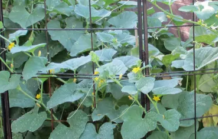You probably just picked your first tomato from your garden so that means it’s time to think about fall gardening! Vegetables maturing in the cool, crisp days of fall are often better flavored than those maturing in the hot, dry days of late spring and summer. Many vegetables can be left in the garden and used as needed into the winter.
Space available and preference will influence the choice of crops to plant for fall production. With attention to watering and pest control, many vegetables that are already growing in the garden will continue to produce into fall. Some of these crops are tomatoes, okra, peppers, New Zealand spinach, eggplant, and sweet potatoes.
Crops that are best adapted to fall culture are mainly cool-season crops, although cucumbers, summer squash, and beans can be grown as fall crops. Most spring vegetables are adaptable to fall gardening, but many Kansas gardeners report little success in growing fall peas.
Cabbage, broccoli, cauliflower, and Brussels sprouts make excellent fall crops. Plant seed rather than transplants. When young plants are ½–¾ inch tall, thin them to one plant per foot of row. Beets and carrots require adequate moisture until they emerge. A light cover of sand or compost over the row may prevent soil crusting and improve emergence.
Freshly cut potato seed pieces will rot easily in warm summer soils. Seed should be cut 3–4 days prior to planting and held at room temperature to heal over. This will prevent seed piece decay. Seed potatoes may be difficult to find in midsummer. Potatoes just harvested should not be used because they will not sprout readily. If you are without a source of seed potatoes, old potatoes from storage or a supermarket can be used. Encourage your plant supply dealer to provide seed potatoes for next year’s fall crop planting season.
Various types of lettuce may experience a marginal leaf burn with a light frost. The center leaves may escape damage, allowing lettuce—especially Bibb or head—to remain past the first frost forecasted.
Many gardeners report success in “overwintering” spinach and kale by using leaves in the fall without harvesting the entire plant. A light mulching through the winter should keep the plants alive to begin growth in the spring without replanting a new crop.
Planting dates are influenced by how long it takes the crop to develop and how tolerant the crop is of first frosts or freezes. Crops such as potatoes or cabbage require a long period of development, thus a mid-July planting date, while crops such as lettuce or radishes can be planted in early September.
Although it is difficult to predict an exact date, the average first frost in the fall occurs in mid-October in most of central and eastern Kansas. It may occur several weeks earlier in northwestern Kansas and several weeks later in southeastern Kansas.
Planting in space used for spring production may require additional fertilizer to support fall crops. Large quantities of fertilizer may damage tender young plants, so use it sparingly this time of year. In general, 1–2 pounds per 100 square feet of a low-analysis, all-purpose garden fertilizer should be sufficient to produce a successful crop.
Although adding organic matter is an excellent practice, it is not a good idea to add quantities before fall planting because this may loosen and dry out soils at a critical time. Save organic matter for a late fall application. Extensive soil preparation probably will not be needed for fall planting. Avoid deep tillage because it may dry out soil. A light surface cultivation will loosen soil to prepare the seedbed.
Additional amounts of fertilizer may be needed later in the season to ensure maximum plant growth and production. Cabbage, broccoli, cauliflower, collards, and kale, plus lettuce, mustard, spinach, and turnip greens will require about 4 tablespoons of a high-nitrogen, all-purpose garden fertilizer per 10 feet of row. It should be sprinkled along the row about 2 weeks after transplanting, or 4 weeks after sowing the seed. This will ensure lush vegetative growth before crop development during cooler fall weather. Other vegetable crops probably will not require any additional fertilization.
Fall gardeners will find that establishing a garden during the summer when soil temperatures are extremely high is difficult. One way to avoid seeding in extremely adverse conditions is to establish plants in containers or pots for transplanting to the garden later in the season as the weather begins to cool. Crops such as cabbage, broccoli, cauliflower, Chinese cabbage, and collards can be grown in a cooler protected area, or under lights in a basement growing area for 2–4 weeks prior to setting in the garden.
It is important to acclimatize crops for several days before transplanting directly in the garden. Place the flats in the direct sun, providing adequate water for 2–4 days to allow the plants to become accustomed to the stronger winds, hot sun, and the harsh environment of the summer garden.
Crops that are seeded directly should be planted slightly deeper than they would be for a spring garden. This has two benefits—it provides a slight cooling effect, as well as more moisture available at the deeper soil depth. It is probably wise to plant more seed than necessary and to do some thinning later to ensure an adequate stand. With frequent watering and heavy, tight soils, a crust may form in planting fall gardens. This can be overcome by a light sprinkling of peat moss, vermiculite, or compost directly over the row.
As in the usual gardening season, the availability of water can influence the success of fall gardening in Kansas. Many areas of the state receive adequate rainfall for successful gardening from late August through September and October. However, trying to establish young seedlings in high temperatures during July to mid-August is difficult without a readily available source of water. Many vegetables can develop a tolerance to a hot temperature, but they cannot tolerate a lack of sufficient soil moisture and cannot germinate without it.
Seeds need adequate moisture to germinate. Germination can be accelerated by soaking seeds overnight before planting. Until seedlings begin to emerge, it may be necessary to supply small quantities of water frequently—perhaps as often as several times a day. In warm summer soil, you will be surprised at how fast many seeds germinate and start to grow. The period of intensive watering lasts only several days
Before planting a fall garden, apply water until the soil is moist to a 10- to 12-inch depth. This will require about 1–1½ inches of water—equivalent to 1½ inches of rainfall—immediately prior to planting. Water can be applied by sprinkling, flooding, or drip irrigation.
As seedlings emerge, you can gradually reduce water because roots penetrate deeper into the soil. In fact, reducing water gradually will encourage deeper rooting of young seedlings, making them more drought tolerant.
In certain instances, a temporary wind screen or windbreak may reduce water loss from soil and protect tender seedlings. Regardless of the system used, it is essential to provide adequate amounts of water deep into the soil for use by vegetables during the critical period of growth.
When plants are small, they may require watering twice a week during dry periods. Try to allow the plants to show slight stress—become slightly limp—before applying water. This will encourage deeper rooting. As plants grow, they will require watering less frequently. In late August and September, natural rain generally will replace watering in most years. A general guideline to follow is that plants will require about an inch of water a week if not supplied by rainfall.
The first frost in the fall will damage some frost sensitive crops. Others may be slightly damaged but will continue to grow for several weeks until a severe freeze kills them. Other crops are hardy and will stand fairly low temperatures. These can be used into the winter months as needed.
Vegetables can be harvested as they mature. From mid- to late October in most areas of Kansas, the weather forecast will indicate when a frost that will freeze tender vegetation is on the way. Many vegetables will have been producing vigorously for 2–4 weeks prior to this date; however, it may be possible to continue harvest for an even longer period of time.
Often, a few nights of low temperatures will be followed by warmer weather for several weeks. If you can protect tender vegetation during these few cold nights, you can continue harvesting vegetables. Some gardeners attempt to gain more days of growing time by covering plants with baskets, blankets, or plastic at the first frost warning.
Concentrate on saving only the tender vegetables which will be easily damaged by a slight frost. Other vegetables that may be growing in the garden and need protection are peppers, eggplant, tomatoes, and sweet potatoes. Temporary coverings of polyethylene plastic, blankets, or tarps may be stretched over the rows to provide frost protection. A small light bulb burning underneath such coverings can provide protection from freezes to around 25°F.





